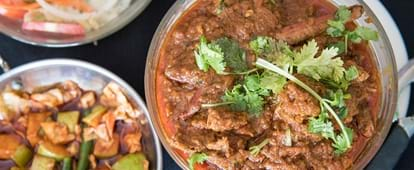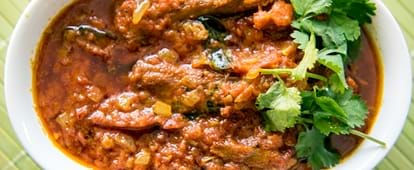By creating an account, I agree to the
Terms of service and Privacy policy
Choose your country and language:
Africa
Americas
Asia Pacific
Europe
AA food group born from the souls of slaves, in its heart, one motto: make sure our people are fed.
Cape Malay cuisine is more than food. It’s a story that continues to live in the mouths of each person who makes their way to Cape Town to taste it. It tells tales of the sweet - like the swollen sultanas you’re bound to find in a platter of Cape Malay yellow rice with raisins. And the sour, like the unexplainable taste of tamarind when you dive face first into a hot plate of Cape Malay fish curry, your tongue tied firmly around the tartness without forgetting the other flavours. Food, flavour, life. When you eat Cape Malay cuisine, you feast on the stories of a people homogenous to only one part of South Africa, in the heart of Cape Town, the Mother City.
In the 1600s, people from the East found their feet flat on the ground at the tip of Africa. The Dutch arrived with slaves from as far as Japan on the one side of the world and Brazil on the other. But most were delivered from Indonesia, Malaysia and India. These exiles led a life of cruelty and hardship at the hands of their captors who had perhaps colonised their bodies, but never their hearts.
And so, the Cape Malay community was born from an intricate web of beliefs, culture, faith and food to feed the soul. The Cape Malay community is a Muslim community and their cuisine grew from and still maintains deep roots in the Islamic tradition of cooking. From the variety of spices used, to the way in which one consumes a meal, that is, with the hands. To taste the sweat of a hard day’s work.
CCape Malay cuisine is comfortable cuisine. It’s the braised lamb you’ll still find on menus in Bo-Kaap if you look for denningvleis, its flavours of cloves, nutmeg and vinegar strong and subtle, all at once. Served with a side of rice, boiled veg and mashed potatoes, this meal, like many other menu items or recipes is wholesome and filling and not a meal that’s fit for one. In the community tradition of the Cape Malays, this food must be cooked to feed families.
The feeding of families was not isolated to the Cape Malay home. Many women during that time were slaves to Dutch households. And so they cooked for their keepers as well. The European tongue is tamer than an Eastern tongue so these women had to find ways around ancestral recipes that called for too much chilli for example. Luckily, Cape Malay cuisine has no shortage of a complex list of ingredients and spices, which followed the slaves all the way to South Africa from their home countries. How do you keep the colour of a meal alive without setting the mouth on fire? You substitute chilli powder for paprika.

CCape Malays were old hands at this kind of modification. A history of people torn from their homelands meant that many ingredients got left behind, and so there was the need for substitution in many cases, which is how Cape Malay cuisine got its authenticity. Through this improvised solo in spices - a little bit of this and a little bit of that - and through repeating all the great notes from different African and European influences and cultures, these people created one strong community song.
The colourful houses that line streets like Wale and Rose in Bo-Kaap are the archives of recipes passed down from generation to generation. And these very recipes make their way onto the sidewalks when the locals lay tables with snacks for passersby. Warm, bite-sized salt and pepper steak pies can be purchased, or koesisters, a Cape Malay-specific confectionary made of deep fried dough (until brown) and then steeped in sugary syrup and dusted with coconut. They’re made fresh and served hot, while you wait.
Cape Malay cuisine
FFor something more substantial, you might want to try a bredie (stew) at a proper Bo-Kaap restaurant like Biesmiellah for example. The word bredie is of Malaysian origin and the form of cooking was introduced by the slaves. It involves a type of vegetable and meat (usually lamb) stewed for a long time.
Legend has it that this meal was born from offcuts and vegetable donations made by slave owners to the slaves who then had to come home and figure out how to cook everything in a way that was not only tasteful but also plentiful, and so, the bredie was born. Bredies typically call for cardamom, cloves, cinnamon and in some cases chilli, and at their heart a feature vegetable. Tomato bredies, cabbage bredies and green bean bredies are among the most popular on a long list of stewed soul foods.
Then of course, you can saunter off to an insider experience and enjoy food at the table of husband-and-wife team Yusuf and Nazli Larney. Their restaurant Bo-Kaap Kombuis is quickly becoming one of the most-visited destinations on the Cape Malay food tour map. Their platters with bite-sized varieties of savoury treats are an absolute winner and the best part is that you get to buy the chilli sauce that’s served with it, so you can take the taste of Bo-Kaap home with you.

FFor the more adventurous, and if you’re keen to take a little more than sauce home with you, why not give Zainie of the Bo-Kaap Cooking School a call. Zainie hosts cooking lessons in her kitchen, and the experience is bound to be a true journey through the taste, culture and life of Bo-Kaap and its people. Indulge in your meal, then take the recipe with you and share the taste at home.
Of course, Cape Malay cuisine is not restricted to the fuss of fancy food served on a hotplate. For the pick-up-and-go variety, Mariam’s Kitchen in the Cape Town CBD is a must. This halaal fast-food joint will hook you up with some of the more famous takeaway treats on the Cape Flats menu. Tuck into a masala steak sandwich or a mince curry rolled up in a fluffy roti, then, if you’re super hungry, I recommend you go for the Gatsby.
If you take a walk up and down the steep hills of Bo-Kaap (where the Cape Malays officially came to settle in the early 19th century), you can still hear the flavours sing, and you can taste the stories of home, the same way the Cape Malay people did all those years ago.

AAbout the author
Haji Mohamed Dawjee became Africa’s first social media editor in a newsroom at the Mail & Guardian, where she went on to work as deputy digital editor and a “disruptor of the peace” through a weekly column. A stint as the programme manager for Impact Africa - a grant-disbursing fund for African digital journalists - followed. She now pursues her own writing full time for EWN and Women 24 with weekly and bi-monthly columns respectively. She also contributes to the Sunday Times and a range of other publications.
Haji's inaugural book of essays: Sorry, Not Sorry: Experiences of a Brown Woman in a White South Africa, was released in April 2018, and is available in paperback as well as on Kindle.
Related articles

